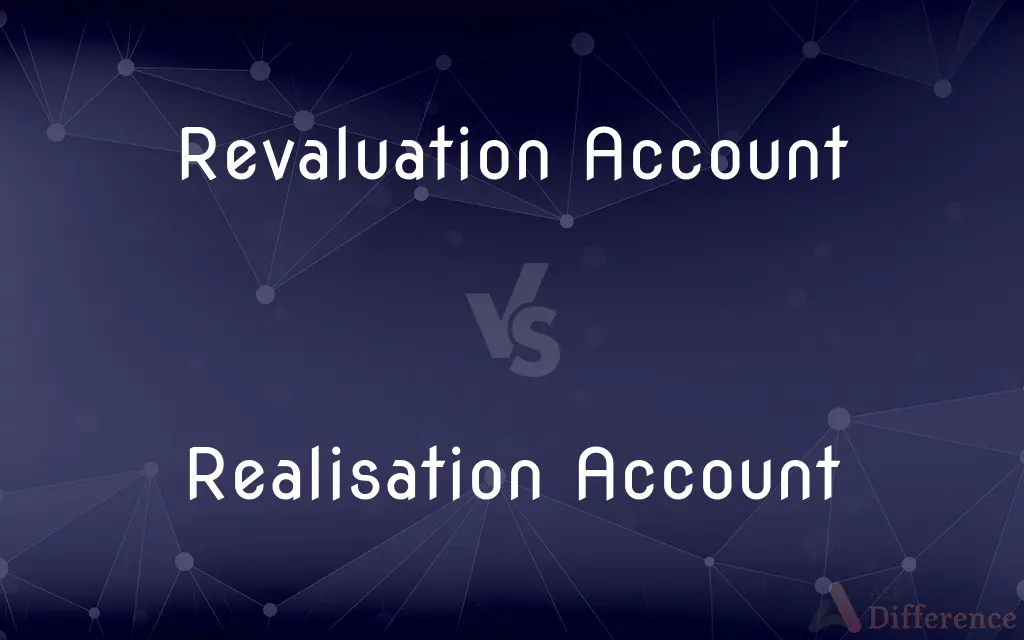Revaluation Account vs. Realisation Account — What's the Difference?
By Tayyaba Rehman — Published on October 13, 2023
Revaluation Account records adjustments in the values of assets and liabilities during reconstitution of a partnership; Realisation Account records the realization of assets and settlement of liabilities during the dissolution of a partnership.

Difference Between Revaluation Account and Realisation Account
Table of Contents
ADVERTISEMENT
Key Differences
In accounting, especially within partnerships, the Revaluation Account and Realisation Account serve distinct purposes. The Revaluation Account is used when there is a change in the partnership deed due to the admission, retirement, or death of a partner, which necessitates the revaluation of assets and reassessment of liabilities. This account records the increase or decrease in the values of assets and liabilities to reflect their true and fair values at the time of reconstitution of the partnership.
In contrast, the Realisation Account is primarily used during the dissolution of a partnership firm. This account comes into play when the business is winding up, and assets are sold, and liabilities are settled. The Realisation Account records the amount realized from the sale of assets and the amount paid to settle the liabilities, along with the distribution of any surplus or deficit among the partners.
The Revaluation Account is not concerned with the realization of assets or payment of liabilities but focuses on adjusting the book values of assets and liabilities to their current values. It provides a clear picture of the financial standing of the partnership at the time of reconstitution. The Realisation Account, on the other hand, is concerned with the actual realization of assets and settlement of liabilities and accurately reflects the financial transactions occurring during the dissolution process.
Both the Revaluation and Realisation Accounts are crucial in providing transparency and accuracy in financial reporting within partnerships. They ensure that the financial statements reflect the true and fair value of the firm's assets and liabilities, whether during reconstitution or dissolution of the partnership, facilitating equitable distribution among the partners and adherence to accounting principles.
Comparison Chart
Purpose
Adjusts values of assets and liabilities during reconstitution.
Records realization of assets and settlement of liabilities during dissolution.
ADVERTISEMENT
Usage
Used during changes in partnership deed.
Used during the winding up of the business.
Focus
Adjusts book values to current values.
Deals with actual realization and settlement.
Impact
Reflects financial standing at reconstitution.
Reflects financial transactions during dissolution.
Relevance
Relevant in partnership reconstitution.
Relevant in partnership dissolution.
Compare with Definitions
Revaluation Account
Revaluation Account is relevant when there is a change in the partnership deed.
The retirement of a partner triggered adjustments in the Revaluation Account to reflect the current financial status of the firm.
Realisation Account
Realisation Account is used to record the actual realization of assets and the settlement of liabilities during the dissolution of a partnership.
When the partnership was dissolved, the Realisation Account displayed the amounts received from asset liquidation and amounts paid to settle debts.
Revaluation Account
Revaluation Account is used to record the adjustments in the values of assets and liabilities during the reconstitution of a partnership.
When a new partner is admitted, the Revaluation Account reflects the changes in asset values and liability assessments.
Realisation Account
Realisation Account records the amounts from the sale of assets and the amounts paid to meet liabilities.
The Realisation Account accurately reflected the proceeds from asset sales and the settlement of outstanding liabilities.
Revaluation Account
Revaluation Account provides a clear picture of the financial standing of a partnership at the time of reconstitution.
The Revaluation Account indicated an appreciation in asset values and a reassessment of liabilities.
Realisation Account
Realisation Account reflects the financial transactions occurring during the dissolution process accurately.
Every transaction during the winding-up phase was meticulously recorded in the Realisation Account.
Revaluation Account
Revaluation Account ensures that the financial statements represent the true and fair values of assets and liabilities.
The adjustments made in the Revaluation Account corrected the disparities in asset valuations and liability assessments.
Realisation Account
Realisation Account is crucial for equitable distribution among the partners during dissolution.
The balances in the Realisation Account were used to determine the final amounts receivable by each partner.
Revaluation Account
Revaluation Account primarily deals with adjusting book values of assets and liabilities to their current values.
The Revaluation Account showed an increase in the value of the building due to market fluctuations.
Realisation Account
Realisation Account comes into play when a business is winding up.
The closing of the firm necessitated the creation of a Realisation Account to manage the final transactions.
Share Your Discovery

Previous Comparison
Formula Mass vs. Molar Mass
Next Comparison
Specific Heat vs. Latent HeatAuthor Spotlight
Written by
Tayyaba RehmanTayyaba Rehman is a distinguished writer, currently serving as a primary contributor to askdifference.com. As a researcher in semantics and etymology, Tayyaba's passion for the complexity of languages and their distinctions has found a perfect home on the platform. Tayyaba delves into the intricacies of language, distinguishing between commonly confused words and phrases, thereby providing clarity for readers worldwide.
















































